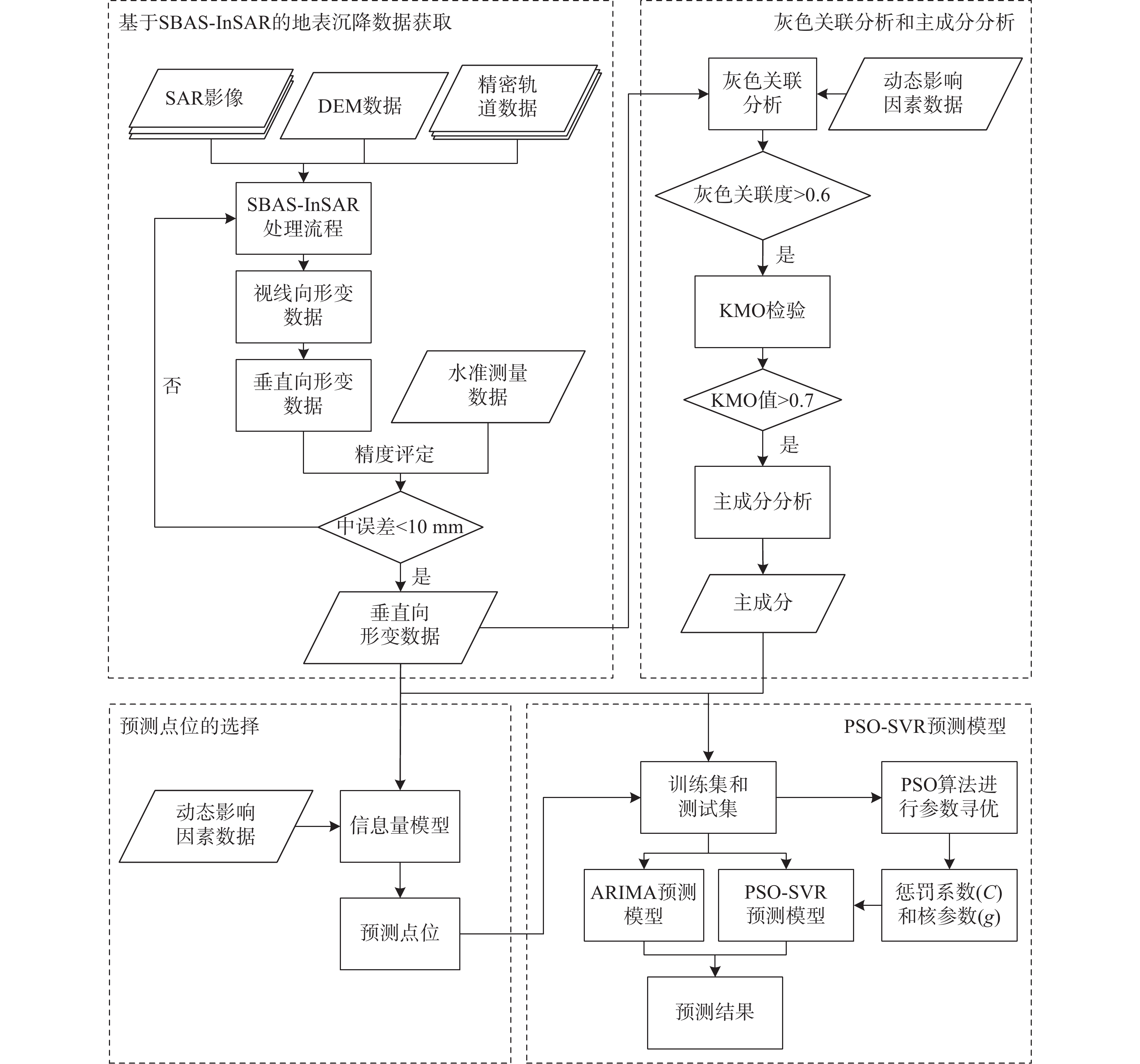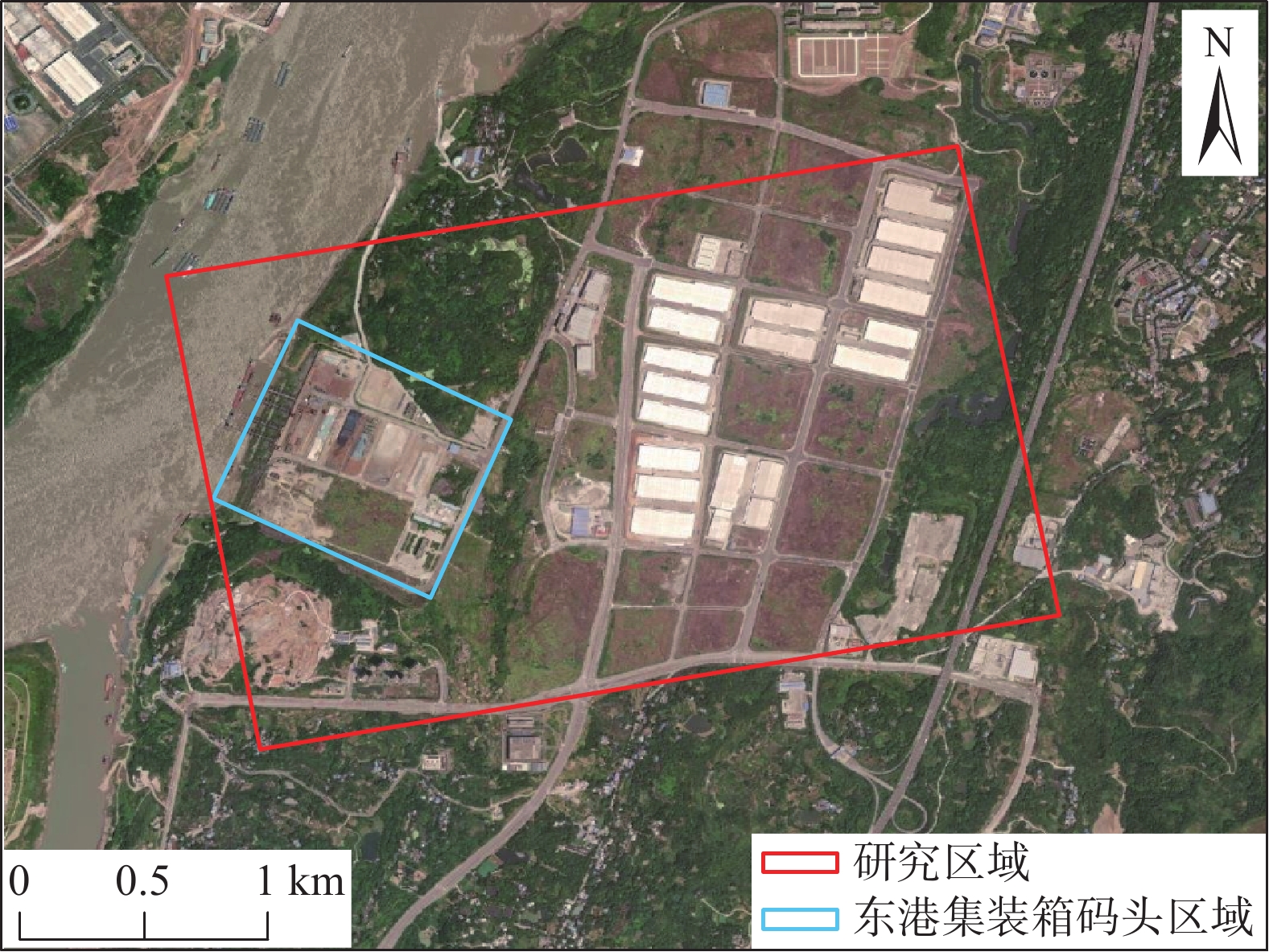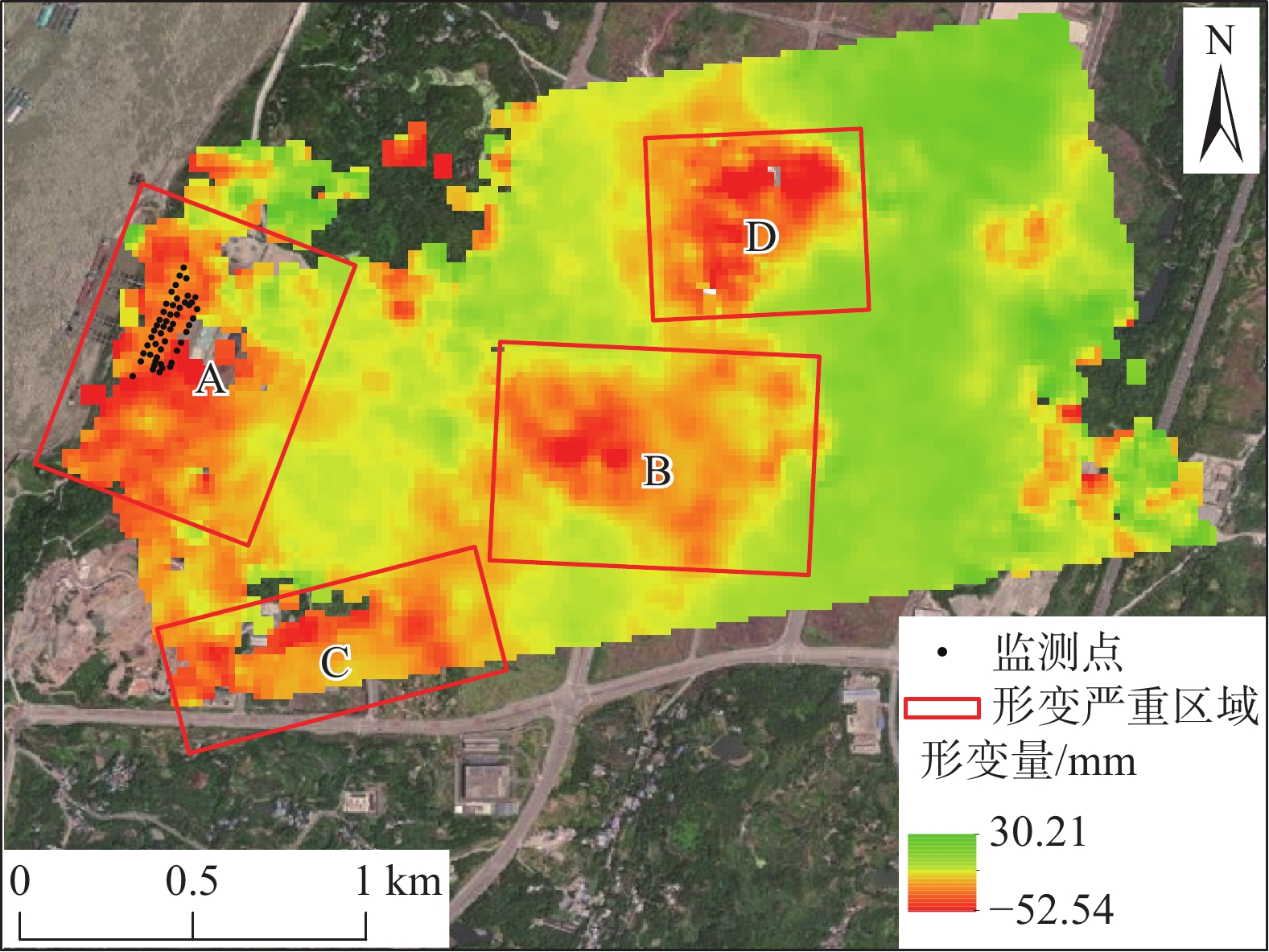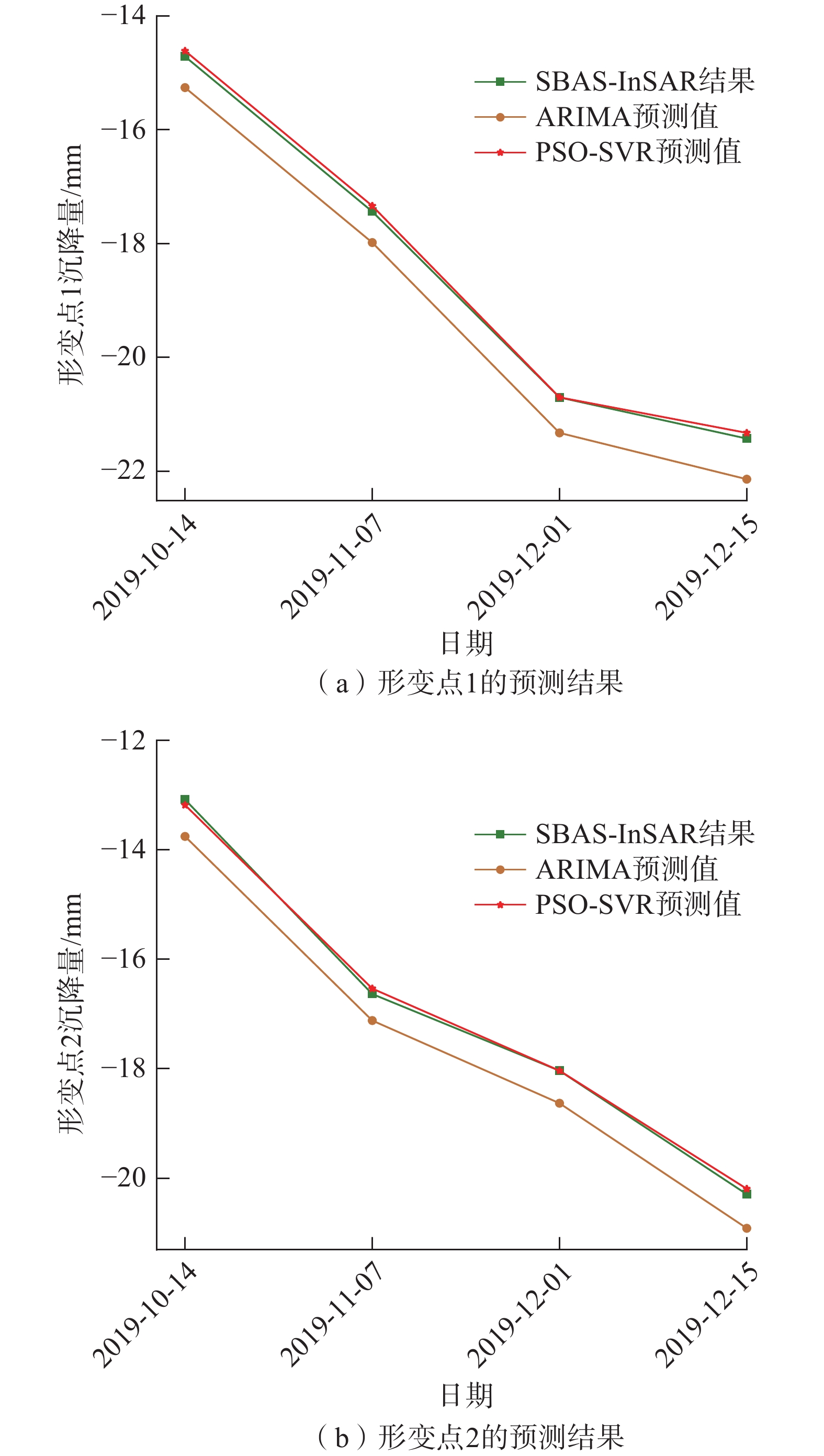Subsidence prediction of high-fill areas based on InSAR monitoring data and the PSO-SVR model
-
摘要:
基于小基线集干涉测量技术(small baseline subsets interferometric synthetic aperture radar, SBAS-InSAR)和机器学习知识对高填方区域进行地表沉降监测及预测,对工程项目的施工、检修、运营等工作都具有重要的指导意义。文章以重庆东港集装箱码头为研究对象,选取2018—2019年覆盖研究区的31景Sentinel-1A数据,利用SBAS-InSAR技术获取该区域的地表沉降数据,并进行内外精度评定;通过信息量模型分析地表沉降易发地地势特点,选择预测点位;通过灰色关联分析计算动态影响因素与沉降量之间的灰色关联度,使用主成分分析法从影响因素中提取出主成分,构建训练集和测试集,通过粒子群算法-支持向量机法(particle swarm optimization-support vector regression, PSO-SVR)预测模型对测试集数据进行预测。为验证该模型在高填方区域沉降预测的可靠性和优异性,将自回归差分整合移动平均模型(autoregressive integrated moving average model, ARIMA)作为对比模型,分别将PSO-SVR模型的预测结果和ARIMA模型的预测结果与测试集进行对比。结果表明:PSO-SVR模型的预测精度优于ARIMA模型,在高填方区域地表沉降预测中具有较好的实用性。
Abstract:Based on SBAS-InSAR technology and machine learning knowledge, the monitoring and prediction of surface settlement in high-fill areas have important guiding significance for construction, maintenance, and operation of engineering projects. This study takes the Chongqing Donggang Container Terminal as the research object, and utilizes 31 scenes of Sentinel-1A data from 2018 to 2019. The surface subsidence data of the area is obtained by SBAS-InSAR technology, and the internal and external accuracy is evaluated. The topography characteristics of the prone areas of surface subsidence were analyzed through an information quantity model to select prediction points. Grey Relational Analysis (GRA) was used to calculate the grey correlation degree between dynamic influencing factors and subsidence. Principal component analysis was used to extract principal components from influencing factors, and training and testing sets were constructed. PSO-SVR prediction model was used to predict the testing set data. To verify the reliability and superiority of the model in subsidence prediction in high-fill areas, the ARIMA model was used as a comparative model, and the prediction results of the PSO-SVR model and the ARIMA model were compared with the testing set. The results show that the prediction accuracy of the PSO-SVR model is better than that of the ARIMA model, and it has better practicality in predicting surface subsidence in high-fill areas.
-
0. 引 言
不稳定边坡是公路沿线常见的一种不良地质灾害现象[1],在降雨情况下,往往会失稳滑动,威胁公路运营安全。公路沿线滑坡体正确处治以地质勘察的准确性作为前提,地质钻探结合调绘工作是滑坡勘察的主流手段。但由于地质钻探工期较长且在不稳定边坡上施工有一定安全隐患,而物探手段具有高效、快捷、可直观成像等特点,因此物探方法发挥的作用越来越大[2-6]。
在公路边坡灾害探测中,常用的物探手段包括:电法[7]、探地雷达、瞬变电磁法、浅层地震等方法,且都取得了不错的效果。单一方法应用研究较多,将电阻率与速度参数有机结合的应用较少。文章依据公路不稳定边坡探测实例,通过常规对称四极电阻率测深与瞬态面波[8-10]相结合,对滑坡体进行勘察,准确高效的圈定滑坡范围,识别滑面及潜在滑面位置,为后续处治工作提供了合理可靠的支撑。
1. 研究区地质概况
1.1 研究区概述
G5京昆高速(雅安至西昌段)90 km附近右侧存在不稳定斜坡,坡高约50 m,为5级坡。通车前已进行过处治,坡角为重力式挡墙,坡体采用框架梁形式进行防护。但在强降雨及周边施工开挖扰动情况下,受重力及水压力作用,出现滑移变形,框架梁发生严重变形错位。边坡表面多处可见土体裂缝,部分框架梁被剪断(图1),对该段高速公路运营威胁极大。
1.2 边坡结构特征
坡角采用重力式挡墙,I、II级坡面为自然削坡后植被防护,由于坡度小,自然坡角稳定,坡体及表面未出现变形现象,上部III—V级坡面采用框架护坡(图2),经地面调查和钻探揭示,防护主体为第四系崩坡残积Q4col+dl碎石土和Q3col+dl碎石土。边坡变形部分主要为Q4col+dl松散含角砾黏土层及部分碎石土层。
1.3 边坡变形特征
依照地质调绘分析,变形段边坡高约50 m,分5级,边坡坡比为1∶1.25,每级边坡高约10 m,平台宽约2 m,边坡上部3~5级边坡为框架锚杆处治,主体为黏土层及崩坡积层块石土,路嵌挡墙为重力式挡墙,墙体无明显变形,下部2级采用削坡及植被护坡。边坡主要为含砾黏土、块石土。I、II级坡面无明显变形,局部有浅表性滑塌,长约5~8 m,影响深度约1 m,钻孔ZK4处于II级平台,出现拉裂缝,其附近坡表变形严重,致使3级坡表框架梁严重变形拉裂,土体呈隆起剪出状。III级平台及IV级平台挡墙前均出现长约30 m贯通性拉裂缝,其中IV级平台挡墙墙体出现变形,下部局部出现淘空现象。V级坡面菱形框架梁出现整体下沉,边缘出现剪断现象。边坡后缘已形成高约1~2 m的陡坎,并形成宽约0.2 m裂缝,深约1 m,有逐渐垮塌后退趋势。滑坡后沿排截水沟出现夸塌拉裂现象。
2. 边坡变形分析及物探方法选择
2.1 边坡变形机理
由于斜坡前期开挖时坡度较陡,坡表植被难以形成较好防护效果,加上长时间降雨渗透使覆盖层抗剪能力减弱,引起坡体失稳。同时,由于Q3c+dl地层较为密实,新近系与第四系地层之间易产生相对富水区,在斜坡重力作用下,逐渐产生滑移现象,并会持续加剧,对防护结构造成破坏,坡体拉裂变形,最终造成整个边坡结构失稳垮塌,严重威胁下方高速公路。因此,需要快速对斜坡开展准确的勘察设计工作。
2.2 边坡地球物理特征分析
通过边坡变形机理分析,主要为富水带引起滑动,从物性特征来看,会产生明显的电阻率及波速变化,且由于斜坡滑动时还会产生裂隙发育区域,附近土体或岩体会造成不同程度的破坏,从而产生明显的物性差异。
通常来说,滑体内波速比稳定区域会明显降低,横波和纵波比(Vp/Vs)也相应增大,且这种变化与岩(土)体破坏程度呈正比。相应的,滑体电阻率也呈类似特征,在含水情况下则会更加明显。
因此,组成滑坡的地质体物性参数与稳定区域存在较=为明显的差异,是利用物探技术研究滑坡的物理基础。
2.3 综合物探方法选择及基本原理
根据2.2节对地球物理特征的分析,本次研究选用电法勘探与瞬态面波相结合的综合物探手段。
2.3.1 电测深勘探基本原理
电测深法[7,11-13]是利用探测地质体的导电性质的不同,根据电阻率的变化特征判断地质体分布情况,完成勘察目标。
根据现场条件及技术要求,本次工作采用对称四极装置进行数据采集,其电极排列方式如图3所示。该装置主要特征为两边极距的对称性,即:
2.3.2 瞬态面波勘探基本原理
相对常用的折射、反射等浅层地震勘探,瞬态面波法[14-17]在20世纪70年代国际上才开始研究,基本原理是通过瑞雷面波频散曲线,采用定量分析,取得不同地下介质弹性波的传播速度,根据速度的差异,可以反映出地层物性差异情况。基于以上原理,能够划分岩土界面、软弱带等,达到解决相应地质问题的目的。瞬态面波勘察法对薄层分辨率高,能通过成像直观表示地下地质体及地质构造,能够在滑坡探测上取得较好的成像效果。
工程勘察时,通常采用瑞雷面波,因此瞬态面波勘探又常称为瑞雷波法,主要具有以下特点:
(1)当传播介质均匀时,瑞雷波波长
层状介质时,
(2)通过计算可知:当深度
根据公式
(3)瑞雷波速度
(1) 根据式(1)得到地质体与
泊松比 0.25 0.38 0.40 0.50 Vr /Vs 0.920 0.939 0.943 0.955 3. 综合物探方法关键技术研究
3.1 电测深关键技术分析
3.1.1 测量装置及极距选择
(1)装置选择:在电法勘探中,根据现场条件进行装置选择是开展工作的一个重要环节,通常来说,装置设计主要由研究区地形条件、目标体规模、测量精度等方面决定,而四极装置可以达到最大的测量电位,能够节省外接电源,减少供电电压,最重要的是可以压制干扰,提高信噪比,在场地条件允许下,为最优选择方案。因此本次研究工作采用对称四极装置,最大供电电压为400 V。
(2)极距选择:电法勘探过程中,极距的选择与勘探深度密切相关,在本次研究中,电法勘探深度要求超过35 m。为了使
3.1.2 研究区电阻率分析测试及解释原则
精确解释的前提是对场区物性参数的准确统计测试,因此,解释前首先要将研究区电阻率参数进行统计,本次依据现场试验及工区综合统计得出以下电阻率参数见表2。
在深度转换时,利用已有钻孔资料进行约束校正,根据钻孔资料揭示的地质分层信息,试验并确定了本次电测深资料解释深度转换采用极距(AB/2)与深度的比值系数为0.95~0.5之间,转换后物探成果解释深度与钻探揭示的地层深度基本吻合。
表 2 研究区电阻率实测参数表Table 2. Measured parameters of resistivity in study area岩性 电阻率值ρ/(Ω·m) 表现特征 黏土层 <200 等值线平滑 稳定堆积体(冰水堆积层) 200~500 等值线紊乱 基岩 >500 等值线平滑 滑面 <200 低阻闭合圈 3.2 瞬态面波关键技术研究
3.2.1 原始数据采集关键问题
在时域内,原始数据采集质量与频散曲线有直接关系。同地震反射类似,瞬态面波法同样有最佳窗口。为提高原始数据精度,增加处理解释精度,面波数据采集时应注意以下关键采集问题:
(1)采样时每道设计排列不能超过面波域,同时采集到足够长记录;
(2)采集时要避开附近振动干扰,减少直达波的后续波或反射、折射波干扰面波;
(3)采集的波形真实可靠。
依照上述原则,排列设计时,应根据勘探深度的要求设计合适的偏移距以及道间距,若偏移距较小,高频分量较大,能凸显浅部信号;要想得到深部信息,则应加大偏移距,使高频分量衰减,凸显低频分量。
在震源选择上,瞬态瑞雷波法的激震可采用大锤或吊锤自由落下,常规来说,勘探深度20~30 m范围内时,24磅大锤激发就能得到较为理想的频散曲线,在介质较软,或勘探深度要求较深时,需要较重吊锤自由落下,能够得到理想的低频震动。
本次研究使用的设备为北京水电物探研究所研制的SWS-6型面波仪,单点激发,12道接收进行数据采集。偏移距10~30 m,道间距l m,采样间隔0.5 ms,记录长度1024 ms。面波的激发采用锤击法,重15 kg。实际工作中,为获取更可靠的面波数据,每个测点上应重复锤击3~5次,采用面波干扰小、能量强、信噪比高的激发记录作为该测点的面波采集数据。
3.2.2 研究区波速分析测试及解释原则
与电法勘探一样,研究区波速参数的准确统计也是面波解释的重要前提条件,由于面波波速近似等于横波波速,因此本次依据现场孔内剪切波测试得出以下参数,见表3。
表 3 研究区横波波速实测参数表Table 3. Measured parameters of shear wave velocity in study area岩性 横波波速v/(m·s−1) 表现特征 粘土层 <200 低速层 稳定堆积体(冰水堆积层) 200~1000 波速变化大 滑面 <200 低速带 数据处理使用SWS-6型面波仪专用处理软件进行,利用频散曲线变化特征分析测点位置面波速度随深度的变化情况,判断地下地质条件。频散曲线与地下介质的层厚度、波速等参数有紧密联系,分析这些变化规律和特征,可以初步确定速度层的层数以及各层的厚度和速度范围,再结合已有地质资料对曲线进行综合分析与定量解释,得到各层的厚度以及波速,达到对地质体分层和识别滑坡的目的。
4. 成果分析
4.1 测线布设
依照现场地形,结合前期调绘圈定的滑坡体的范围,垂直布置纵横两条剖面(沿高速公路方向为纵剖面,垂直高速路线方向为横剖面),电测深法与面波法测线重合,以便互相验证。具体测线位置见图4。
4.2 物探成果解释
根据上述处理解释方法得到物探解释成果图件(图5、6、7、8),结合地质调绘资料进行综合地质解释。
根据解释资料分析:面波横剖面(图5)中30~80 m范围,表层3~5m深度存在明显低速带,波速
在电测深成果图中(图7、图8),分层也较为清晰,能够得出明确的三层界面:黏土层、稳定堆积体层以及基岩,但纵向分辨率较面波成果低,较难识别出滑面具体位置,解释时要参考面波成果图进行滑面判别。
依照两种方法成果综合分析,滑坡体厚度约为3~4 m,剖面75 m附近较厚,约6~7 m,推测在横剖面30 m处剪出,横剖面90 m处为滑坡后缘,覆盖层整体厚度超过30 m,滑坡体及覆盖层形态见图5~8。
4.3 地质验证
(1)结合现场坡体变形情况,坡体剪出位置与物探推测位置吻合,边坡在测线58 m、72 m、97 m、103 m和116 m处出现土体裂缝及部分框架梁破坏位置,均在物探推测滑坡体范围内,变形范围与物探成果推测一致;根据现场调绘的滑体厚度也与推测结果一致。
(2)依照综合物探解释成果,结合地质调绘,在推测主滑面位置布设5个钻孔,绘制出边坡综合地质成果图(图9),钻探揭示滑面深度、滑坡体规模等与物探结果基本吻合,表明综合物探能在不稳定边坡勘察中取得良好效果。
5. 结论
(1)综合瞬态面波与电测深成果,较为准确的推测出滑坡体的规模、形态以及滑面位置,与地质资料对比,两者具有很好的一致性。
(2)电法勘探与面波勘探相结合,可互相验证,利于消除物探多解性,在滑坡探测中具有快速、有效、直观的特点,可在类似条件下滑坡识别进行推广应用。
(3)由于地质体不同物性参数的差异,造成不同物探方法对地质体表现结果并不完全一致,解释时必须有效结合地质调绘及钻孔信息,去伪存真,才能发挥物探工作的作用,没有地质基础的物探解释可能会造成误判。
-
表 1 监测点地表形变结果
Table 1 Surface deformation results of monitoring sites
点名 基于SBAS-InSAR技术获取的LOS向形变数据/mm 基于SBAS-InSAR技术获取的垂直形变数据/mm 水准测量获取的形变量/mm 1 −12.75 −15.26 −15.20 2 −13.62 −16.29 −13.60 3 −13.62 −16.29 −9.20 …… …… …… …… 46 −22.75 −27.22 −39.80 47 −21.42 −25.63 −36.00 48 −20.45 −24.46 −17.40 表 2 静态影响因素信息量计算结果
Table 2 Information quantity calculation results of static influencing factors
静态影响因子 影响因子分级 信息量 高程/m 151~187 0.82 187~231 0.07 231~263 0.64 263~292 −1.28 292~333 −5.62 坡度/(°) 0~5 −0.32 5~10 0.00 10~15 0.08 15~20 0.37 >20 0.20 坡向 平坡 −1.78 北坡 0.36 东北坡 −0.02 东坡 −0.80 东南坡 −0.47 南坡 −0.16 西南坡 0.42 西坡 −0.21 西北坡 0.23 平面曲率 0~16.9 0.05 16.9~33.6 −0.22 33.6~50.5 −0.14 50.5~67.4 −0.19 67.4~81.5 0.31 剖面曲率 0~2.9 0.01 2.9~5.8 −0.01 5.8~9 −0.11 9~13.6 0.24 13.6~26.8 −0.23 道路缓冲区/m 0~30 −0.78 30~60 −0.19 60~90 0.13 >90 0.28 水系缓冲区/m 0~500 −0.08 500~1000 0.68 1000~1500 −0.74 1500~2 000 0.48 >2 000 −2.68 地形起伏度/m 0~7 −0.48 7~13 0.00 13~19 0.13 19~29 0.25 29~48 0.26 人类活动缓冲区/m 0~100 0.56 100~200 −1.07 200~300 −1.13 300~400 −0.64 >400 −1.89 表 3 灰色关联度
Table 3 Summary table of grey relational degree
影响因素 气温 水位 地下水 NDVI 降雨量 灰色关联度 0.758 4 0.758 3 0.692 9 0.666 7 0.622 3 表 4 PSO-SVR模型的预测结果
Table 4 Prediction results of the PSO-SVR model
点号 日期 真实值/mm 预测值/mm 形变点1 2019-10-14 −14.71 −14.61 2019-11-07 −17.43 −17.34 2019-12-01 −20.71 −20.70 2019-12-25 −21.42 −21.32 形变点2 2019-10-14 −13.08 −13.18 2019-11-07 −16.63 −16.53 2019-12-01 −18.04 −18.03 2019-12-25 −20.29 −20.19 表 5 ARIMA模型的预测结果
Table 5 Prediction results of the ARIMA model
点号 日期 真实值/mm 预测值/mm 形变点1 2019-10-14 −14.71 −15.26 2019-11-07 −17.44 −17.98 2019-12-01 −20.70 −21.32 2019-12-25 −21.42 −22.14 形变点2 2019-10-14 −13.08 −13.75 2019-11-07 −16.63 −17.12 2019-12-01 −18.04 −18.63 2019-12-25 −20.29 −20.91 表 6 精度评定表
Table 6 Accuracy evaluation table
模型 点号 MAE MSE R2 PSO-SVR 形变点1 0.075 3 0.007 5 0.999 0 形变点2 0.075 0 0.007 5 0.998 9 ARIMA 形变点1 0.606 9 0.373 1 0.948 3 形变点2 0.593 3 0.356 8 0.947 9 -
[1] 刘强. 时序InSAR技术在中型城市地表形变时空特征应用及预测分析[D]. 抚州: 东华理工大学, 2022 LIU Qiang. Application and prediction analysis of time series InSAR technology in temporal and spatial characteristics of surface deformation in medium-sized cities[D]. Fuzhou: East China Institute of Technology, 2022. (in Chinese with English abstract)
[2] 李金超. 基于InSAR和Sentinel-1A的淮南矿区形变灾害监测研究[D]. 合肥: 合肥工业大学, 2021 LI Jinchao. Research on deformation disaster monitoring in Huainan mining area based on InSAR and sentinel-1A[D]. Hefei: Hefei University of Technology, 2021. (in Chinese with English abstract)
[3] FERRETTI A,PRATI C,ROCCA F. Permanent scatterers in SAR interferometry[J]. IEEE Transactions on Geoscience and Remote Sensing,2001,39(1):8 − 20. DOI: 10.1109/36.898661
[4] BERARDINO P,FORNARO G,LANARI R,et al. A new algorithm for surface deformation monitoring based on small baseline differential SAR interferograms[J]. IEEE Transactions on Geoscience and Remote Sensing,2002,40(11):2375 − 2383. DOI: 10.1109/TGRS.2002.803792
[5] 于书媛,杨源源,张鹏飞,等. 运用时序InSAR技术监测合肥市地面沉降及断裂活动[J]. 大地测量与地球动力学,2021,41(4):398 − 402. [YU Shuyuan,YANG Yuanyuan,ZHANG Pengfei,et al. Monitoring land subsidence and fault activity in Hefei City based on MT-InSAR[J]. Journal of Geodesy and Geodynamics,2021,41(4):398 − 402. (in Chinese with English abstract) DOI: 10.14075/j.jgg.2021.04.014 Yu Shuyuan, Yang Yuanyuan, Zhang Pengfei, et al. Monitoring land subsidence and fault activity in Hefei city based on MT-InSAR[J]. Journal of Geodesy and Geodynamics, 2021, 41(4): 398-402. (in Chinese with English abstract) DOI: 10.14075/j.jgg.2021.04.014
[6] 代聪,李为乐,陆会燕,等. 甘肃省舟曲县城周边活动滑坡InSAR探测[J]. 武汉大学学报(信息科学版),2021,46(7):994 − 1002. [DAI Cong,LI Weile,LU Huiyan,et al. Active landslides detection in Zhouqu County,Gansu Province using InSAR technology[J]. Geomatics and Information Science of Wuhan University,2021,46(7):994 − 1002. (in Chinese) DAI Cong, LI Weile, LU Huiyan, et al. Active landslides detection in Zhouqu County, Gansu Province using InSAR technology[J]. Geomatics and Information Science of Wuhan University, 2021, 46(7): 994-1002. (in Chinese)
[7] 赵现仁. 基于时序干涉SAR的北极地区冰川运动监测分析[D]. 北京: 北京建筑大学, 2020 ZHAO Xianren. Monitoring and analysis of glacier movement in arctic based on time series interferometric SAR[D]. Beijing: Beijing University of Civil Engineering and Architecture, 2020. (in Chinese with English abstract)
[8] 周定义,左小清. 基于SBAS-InSAR和PSO-BP神经网络算法的矿区地表沉降监测及预测[J]. 云南大学学报(自然科学版),2021,43(5):895 − 905. [ZHOU Dingyi,ZUO Xiaoqing. Surface subsidence monitoring and prediction in mining area based on SBAS-InSAR and PSO-BP neural network algorithm[J]. Journal of Yunnan University (Natural Sciences Edition),2021,43(5):895 − 905. (in Chinese with English abstract) ZHOU Dingyi, ZUO Xiaoqing. Surface subsidence monitoring and prediction in mining area based on SBAS-InSAR and PSO-BP neural network algorithm[J]. Journal of Yunnan University (Natural Sciences Edition), 2021, 43(5)895-905(in Chinese with English abstract)
[9] 师芸,李杰,吕杰,等. 结合SBAS-InSAR与支持向量回归的开采沉陷监测与预测[J]. 遥感信息,2021,36(2):6 − 12. [SHI Yun,LI Jie,LYU Jie,et al. Monitoring and prediction of mining subsidence based on SBAS-InSAR and improved support vector regression[J]. Remote Sensing Information,2021,36(2):6 − 12. (in Chinese with English abstract) DOI: 10.3969/j.issn.1000-3177.2021.02.002 SHI Yun, LI Jie, LV Jie, et al. Monitoring and prediction of mining subsidence based on SBAS-InSAR and improved support vector regression[J]. Remote Sensing Information, 2021, 36(2)6-12(in Chinese with English abstract) DOI: 10.3969/j.issn.1000-3177.2021.02.002
[10] CORTES C,VAPNIK V. Support-vector networks[J]. Machine Learning,1995,20(3):273 − 297.
[11] 喜文飞,杨正荣,赵子龙,等. 基于SBAS-InSAR技术的小区域沉降监测研究[J]. 云南师范大学学报(自然科学版),2022,42(4):41 − 44. [XI Wenfei,YANG Zhengrong,ZHAO Zilong,et al. Study on settlement monitoring in small area based on the SBAS-InSAR technology[J]. Journal of Yunan Normal University (Natural Sciences Edition),2022,42(4):41 − 44. (in Chinese with English abstract) XI Wenfei, YANG Zhengrong, ZHAO Zilong, et al. Study on settlement monitoring in small area based on the SBAS-InSAR technology[J]. Journal of Yunan Normal University (Natural Sciences Edition), 2022, 42(4)41-44(in Chinese with English abstract)
[12] 杨康,薛喜成,李识博. 信息量融入GA优化SVM模型下的地质灾害易发性评价[J]. 安全与环境工程,2022,29(3):109 − 118. [YANG Kang,XUE Xicheng,LI Shibo. Geological hazard susceptibility assessment by incorporating information value into GA optimized SVM model[J]. Safety and Environmental Engineering,2022,29(3):109 − 118. (in Chinese with English abstract) DOI: 10.13578/j.cnki.issn.1671-1556.20210976 YANG Kang, XUE Xicheng, LI Shibo. Geological hazard susceptibility assessment by incorporating information value into GA optimized SVM model[J]. Safety and Environmental Engineering, 2022, 29(3)109-118(in Chinese with English abstract) DOI: 10.13578/j.cnki.issn.1671-1556.20210976
[13] 谭学瑞,邓聚龙. 灰色关联分析:多因素统计分析新方法[J]. 统计研究,1995,12(3):46 − 48. [TAN Xuerui,DENG Julong. Grey connected analysis: A new method of multifactor statistical analysis[J]. Statistical Research,1995,12(3):46 − 48. (in Chinese with English abstract) TAN Xuerui, DENG Julong. Grey Connected Analysis: A New Method of Multifactor Statistical Analysis[J]. Statistical Research, 1995, 12(3): 46-48.(in Chinese with English abstract)
[14] 何旭,何毅,张立峰,等. 联合InSAR与PCA的北京平原地面沉降时空分析[J]. 光谱学与光谱分析,2022,42(7):2315 − 2324. [HE Xu,HE Yi,ZHANG Lifeng,et al. Spatio-temporal analysis of land subsidence in Beijing plain based on InSAR and PCA[J]. Spectroscopy and Spectral Analysis,2022,42(7):2315 − 2324. (in Chinese with English abstract) HE Xu, HE Yi, ZHANG Lifeng, et al. Spatio-temporal analysis of land subsidence in beij ing plain based on InSAR and PCA[J]. Spectroscopy and Spectral Analysis, 2022, 42(7)2315-2324(in Chinese with English abstract)
[15] KENNEDY J, EBERHART R. Particle swarm optimization[C]//Proceedings of ICNN'95 - International Conference on Neural Networks. November 27 - December 1, 1995, Perth, WA, Australia. IEEE, 2002: 1942-1948.
[16] 韩冰,袁颖. 基于主成分分析的GA-SVM地表沉降预测模型[J]. 中国科技论文,2018,13(9):1045 − 1049. [HAN Bing,YUAN Ying. Application of GA-SVM model based on principal component nalysis to prediction of surface settlement of shield construction[J]. China Science Paper,2018,13(9):1045 − 1049. (in Chinese with English abstract) HAN Bing, YUAN Ying. Application of GA-SVM model based on principal component nalysis to prediction of surface settlement of shield construction[J]. China Sciencepaper, 2018, 13(9): 1045-1049. (in Chinese with English abstract)
[17] 冯小蔓. 基于InSAR技术的地表形变与雪深监测研究[D]. 太原: 太原理工大学, 2021 FENG Xiaoman. Research on monitoring of surface deformation and snow depth based on InSAR technology[D]. Taiyuan: Taiyuan University of Technology, 2021. (in Chinese with English abstract)
[18] 潘建平,邓福江,徐正宣,等. 基于轨道精炼控制点精选的极艰险区域时序InSAR地表形变监测[J]. 中国地质灾害与防治学报,2021,32(5):98 − 104. [PAN Jianping,DENG Fujiang,XU Zhengxuan,et al. Time series InSAR surface deformation monitoring in extremely difficult area based on track refining control points selection[J]. The Chinese Journal of Geological Hazard and Control,2021,32(5):98 − 104. (in Chinese with English abstract) DOI: 10.16031/j.cnki.issn.1003-8035.2021.05-12 PAN Jianping, DENG Fujiang, XU Zhengxuan, et al. Time series InSAR surface deformation monitoring in extremely difficult area based on track refining control points selection[J]. The Chinese Journal of Geological Hazard and Control, 2021, 32(5): 98-104. (in Chinese with English abstract) DOI: 10.16031/j.cnki.issn.1003-8035.2021.05-12
[19] FAN Hongdong,WANG Liang,WEN Binfan,et al. A new model for three-dimensional deformation extraction with single-track InSAR based on mining subsidence characteristics[J]. International Journal of Applied Earth Observation and Geoinformation,2021,94:102223. DOI: 10.1016/j.jag.2020.102223
[20] 杨沛璋,崔圣华,裴向军,等. 基于SBAS-InSAR和光学遥感影像的大型倾倒变形体变形演化[J]. 地质科技通报,2023,42(6):63 − 75. [YANG Peizhang,CUI Shenghua,PEI Xiangjun,et al. Deformation and evolution of large dumping bodies based on SBAS-InSAR and optical remote sensing images[J]. Bulletin of Geological Science and Technology,2023,42(6):63 − 75. (in Chinese with English abstract) [YANG Peizhang, CUI Shenghua, PEI Xiangjun, et al. Deformation and evolution of large dumping bodies based on SBAS-InSAR and optical remote sensing images[J]. Bulletin of Geological Science and Technology, 2023, 42(6): 63-75.(in Chinese with English abstract)
[21] 中国国土资源航空物探遥感中心. 地面沉降干涉雷达数据处理技术规程: DD 2014−11[S]. 北京: 中国地质调查局, 2014 China Aero Geophysical Survey and Remote Sensing Center for Land and Resources. Technical specification for data processing of land subsidence interference radar: DD 2014−11[S]. Beijing: China Geological Survey, 2014. (in Chinese)
[22] 杜国梁,杨志华,袁颖,等. 基于逻辑回归-信息量的川藏交通廊道滑坡易发性评价[J]. 水文地质工程地质,2021,48(5):102 − 111. [DU Guoliang,YANG Zhihua,YUAN Ying,et al. Landslide susceptibility mapping in the Sichuan-Tibet traffic corridor using logistic regression-information value method[J]. Hydrogeology & Engineering Geology,2021,48(5):102 − 111. (in Chinese with English abstract) DU Guoliang, YANG Zhihua, YUAN Ying, et al. Landslide susceptibility mapping in the Sichuan-Tibet traffic corridor using logistic regression-information value method[J]. Hydrogeology & Engineering Geology, 2021, 48(5): 102-111. (in Chinese with English abstract)
[23] 刘刚,徐成华,施威,等. 南京河西地区地面沉降成因分析[J]. 地质论评,2023,69(2):639 − 647. [LIU Gang,XU Chenghua,SHI Wei,et al. Cause analysis of land subsidence in Hexi area,Nanjing[J]. Geological Review,2023,69(2):639 − 647. (in Chinese with English abstract) DOI: 10.16509/j.georeview.2022.08.081 Liu Gang, Xu Chenghua, Shi Wei, et al. Cause analysis of land subsidence in Hexi area, Nanjing[J]. Geological Review, 2023, 69(2): 639-647. (in Chinese with English abstract) DOI: 10.16509/j.georeview.2022.08.081
[24] 葛伟丽,李元杰,张春明,等. 基于InSAR技术的内蒙古巴彦淖尔市地面沉降演化特征及成因分析[J]. 水文地质工程地质,2022,49(4):198 − 206. [GE Weili,LI Yuanjie,ZHANG Chunming,et al. An attribution analysis of land subsidence features in the city of Bayannur in Inner Mongolia based on InSAR[J]. Hydrogeology and Engineering Geology,2022,49(4):198 − 206. (in Chinese with English abstract) DOI: 10.16030/j.cnki.issn.1000-3665.202106022 GE Weili, LI Yuanjie, ZHANG Chunming, et al. An attribution analysis of land subsidence features in the city of Bayannur in Inner Mongolia based on InSAR[J]. Hydrogeology and Engineering Geology, 2022, 49(4)198-206(in Chinese with English abstract) DOI: 10.16030/j.cnki.issn.1000-3665.202106022
[25] 秦胜伍,张延庆,张领帅,等. 基于Stacking模型融合的深基坑地面沉降预测[J]. 吉林大学学报(地球科学版),2021,51(5):1316 − 1323. [QIN Shengwu,ZHANG Yanqing,ZHANG Lingshuai,et al. Prediction of ground settlement around deep foundation pit based on stacking model fusion[J]. Journal of Jilin University (Earth Science Edition),2021,51(5):1316 − 1323. (in Chinese with English abstract) Qin Shengwu, Zhang Yanqing, Zhang Lingshuai, et al. Prediction of ground settlement around deep foundation pit based on stacking model fusion[J]. Journal of Jilin University (Earth Science Edition), 2021, 51(5): 1316-1323. (in Chinese with English abstract)
-
期刊类型引用(6)
1. 赵亚文,刘勇,刘长青. 小型加筋土试件电阻率响应特征. 山东交通学院学报. 2025(02): 71-76 .  百度学术
百度学术
2. 朱瑞,任云峰,熊奇,薛寒. 综合物探探测豫北灰岩区薄覆盖层隐伏断层方法研究. 水文地质工程地质. 2024(01): 154-166 .  百度学术
百度学术
3. 吴庆良,唐彬雪,王惠贤. 综合物探方法在黏土地区开挖隧道的应用. 西南大学学报(自然科学版). 2023(06): 192-200 .  百度学术
百度学术
4. 马志超,窦文武,李文,廉玉广,李汉超,李雁川,申桄会,程海林. 煤矿回采工作面内部不良地质体的多波联合探测. 中国地质灾害与防治学报. 2023(03): 83-92 .  本站查看
本站查看
5. 王小川. 物探方法在高速公路勘察中的应用. 工程技术研究. 2023(10): 36-38 .  百度学术
百度学术
6. 赵全升,孔智涵,胡舒娅,张建伟. 柴达木盆地马海盐湖地下卤水地球物理探测及应用. 吉林大学学报(地球科学版). 2023(05): 1560-1572 .  百度学术
百度学术
其他类型引用(2)




 下载:
下载:














































 邮件订阅
邮件订阅 RSS
RSS